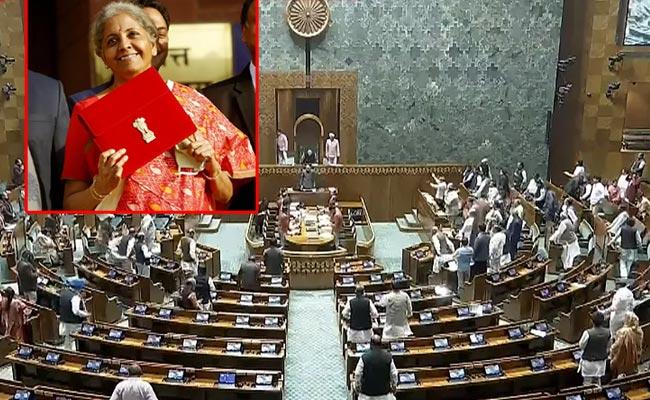Interim Union Budget 2024 Highlights: Check Key Features Here!

Budget 2024 Highlights
Below are the highlights from Nirmala Sitharaman's Speech
- Indian economy has witnessed profound transformation in the last 10 years.
- Govt. built on Sabka Saath, Sabka Vikas, Sabka Vishwaas Mantra.
- Jai Vigyan, Jaikisan, Jai Anundhan is the main objective of this government.
- We need to focus on four major groups -- Poor, farmers, youth and women. Nirmala Sitharaman said that their needs and aspirations are our highest priority. The country progresses when they progress.
- We are working to make India a Vikashit Bharat by 2047, says FM.
- We are moving towards achieving the goals set by 2047.
- Economic growth is seen in all sectors.
- Tax reforms like GST have increased the scope of tax.
- We have provided one-third reservation for women.
- Given a new meaning to GDP which means Governance, Development and Performance.
- Kept inflation in balance in these ten years.
- A special carriage from India to Europe via the Middle East.
- We are transforming the eastern region of the country into a new chariot of development.
- Demography, democracy and diversity are the basic principles of India moving forward.
- A new mission for self-sufficiency in defense sector.
- A push for defense sector towards integrated technological development.
- The average monthly GST income has reached Rs.1.66 crore.
- The current income is double than the pre-GST regime.
- New Reforms in International Trade. We are setting up a new containership pole in water and air routes.
- Promotes use of electric vehicles
- 75 thousand crore loans to states with a tenure of 50 years for a developed India.
Sustainable Development
- Commitment to meet 'Net Zero ’by 2070
- Viability gap funding for wind energy
- Setting up of coal gasification and liquefaction capacity
- Phased mandatory blending of CNG, PNG and compressed biogas.
- Financial assistance for procurement of biomass aggregation machinery
- Rooftop solarization-1 crore households will be enabled to obtain up to 300 units of free electricity per month.
- Adoption of e-buses for public transport network.
- Strengthening e-vehicle ecosystem by supporting manufacturing and charging
- New scheme of biomanufacturing and bio-foundry to be launched to support environment friendly alternatives.
Infrastructure and Investment
- Implementation of 3 major railway corridor programmes under PM Gati Shakti-to improve logistics efficiency and reduce cost.
- Promotion of foreign investment via bilateral investment treaties to be negotiated.
- Expansion of existing airports and comprehensive development of new airports under UDAN scheme
- All the coaches of the train will be converted to Vande Bharat standards.
- New flights to tier 2 and 3 cities in the aviation sector.
- Construction of new infrastructure in high-traffic and high-density corridors on rail lines.
- Promotion of urban transformation via Metro rail and NaMo Bharat
Allocations for various central government schemes in the interim budget 2024
- Rural Employment Guarantee Scheme: Rs. 86 thousand crores
- Ayushman Bharat: Rs. 7,500 crores
- Industrial incentives: Rs. 6,200 crores
- Manufacturing of Semiconductors, Display Echo Systems: Rs. 6,903 crores
- Solar Power Grid: Rs. 8,500 crores
- Green Hydrogen Mission: Rs. 600 crores
Allocations to various departments in the Interim Budget 2024
- Defense: Rs 6.2 lakh crore
- Land Transport, National Highways: Rs. 2.78 lakh crores
- Railway: Rs. 2.55 lakh crores
- Consumer Affairs, Food, Public Distribution: Rs. 2.13 lakh crores
- Home Department: Rs. 2.03 lakh crores
- Rural Development: Rs. 1.77 lakh crores
- Chemicals, Fertilizers: Rs. 1.68 lakh crores
- Communications: Rs. 1.37 lakh crores
- Agriculture and Farmers Welfare: Rs. 1.27 lakh crores
No relief to income tax groups
- The new tax policy proposed last year will be continued this time.
- She said that the rebate will be up to Rs.7 lakh without any tax burden.
- This has nothing to do with savings and investments. Tax is applicable according to the slabs for those with income above that.
- No changes have been proposed in the old taxation system which allowed exemptions under various sections.
- In the new tax system, the exemption is increased to Rs.3 lakh.
- Under the old tax system, the income limit remains at Rs 2,50,000.
- Even in the old tax system, there is no burden when the taxable income is less than Rs.5 lakh.
- Certain tax benefits to Start-ups and investments made by sovereign wealth funds/pension funds, tax exemption of some IFSC units earlier expiring on 31.03.2024 extended up to 31.03.2025.
- Withdrawal of outstanding direct tax demand: Up to ₹25,000 pertaining up to FY10 and Up to ₹10,000 for FY11-FY15, expected to benefit approx. 1 crore taxpayers.
Infrastructure:
- Infrastructure sector with 11.1 percent growth and allocation of Rs.11 lakh 11 thousand 111 crore.
- We have announced a new solar scheme to get rid of electricity bills.
- Door to door electricity, employment and drinking water are slogans for inclusive development.
- Interest-free loans of Rs. 75 thousand crores for 50 years to the states for the implementation of reforms.
- FDI stands for First Develop India. FDI investments have increased. It was a golden age for foreign investment.
- We will provide support to the states in the development of tourist areas.
- Metro rail in more cities
- E-buses in cities.
Health:
- Rainbow program for child health.
- We will form committees for more medical colleges.
- Five new integrated aqua parks in the country.
- Encourage Cervical Cancer Vaccination for girls (9-14 years) Saksham Anganwadi and Poshan 2.0 to be expedited for improved nutrition delivery, early childhood care and development.
- U-WIN platform for immunisation efforts of Mission Indradhanush to be rolled out.
- Health cover under Ayushman Bharat scheme to be extended to all ASHA, Anganwadi workers and helpers.
Housing:
- Priority is given to construction of houses for the middle class.
- Working with the states for the development of districts and blocks.
- 300 units of free electricity per crore houses under roof top solar policy.
- We will make the dream of own home come true for those living in slums and rented houses.
- In rural areas, 70 percent of PM Awas Yojana houses have been given in the name of women.
- Construction of 3 crore houses under PM Awas Yojana in next five years.
Poor
- In last 10 year, 25 cr people have been out of poverty.
- Provided Rs.34 lakh crores to the poor through Jandhan accounts.
- With inclusive and balanced economic policies, progress has been made to the last individual.
- Insurance facility for 4.50 crore people
- Financial assistance to 78 lakh street vendors.
- Provided unsecured loans of Rs.2.20 lakh crore.
- People's income has increased by 50 percent.
Women:
- Application of Ayushman Scheme to Ashas and Anganwadis.
- Measures to prevent cervical cancer among girls aged 9-18 years.
- The number of girls studying higher education has increased by 28 percent in 10 years.
- Millions of women have become millionaires through Self Help Groups.
- Increasing the target of Lak Pati Didi from two crores to three crores.
- Triple talaq has been declared illegal.
Education & Youth
- We have made youth entrepreneurs through Startup India.
- With the new reforms, new entrepreneurs were born.
- Skill training to 1 crore 40 lakh youth with Skill India Mission
- Established 7 IITs, 16 triple ITs, 7 IIMs, 15 AIIMS and 390 universities in the last ten years.
- Given loans of Rs.25 lakh crores to the youth under the Mudra Yojana.
- Set up a fund of Rs. lakhs of crores for research and creativity.
- Loans for starting Start-ups and industries.
- Upto 50 years interest free loans for tech start-ups
- 43 percent of female enrolment in STEM courses.
Agriculture:
- Our government has breathed new life into the collapsing agriculture sector.
- We have provided benefits to farmers with support prices and investment subsidies.
- Financial assistance to 11.8 crore farmers through PM Kisan Samman Nidhi.
- Value addition policies with new technology in agriculture sector.
- Implementation of Pradhan Mantri Matsaya Sampada Yojana to be stepped up to enhance aquaculture productivity, double exports and generate more employment opportunities
- Crop insurance to 4 crore farmers under Fasal Bima Yojana
- After Nano Urea we provide fertilizers under Nano DAP to the crops.
- We will achieve self-reliance in the field of oil seeds.
- New income streams for farming sectors with new knowledge and market system integration
- Financial assistance for warehousing and processing of cultivated produce
- Atmanirbhar Oilseeds Abhiyaan-Strategy to be formulated to achieve atmanirbhar for oilseeds.
- Financial assistance to farmers for dairy development financed by Rashtriya Dairy Processing Gokula Mission.
- Integration of 1,361 mandis under e- NAM, supporting trading volume of ₹3 lakh crore.
The last session of Parliament before the general elections began on Wednesday. The budget will be introduced as part of this. President Draupadi Murmu addressed both the Houses on this occasion. This is the first time for the President to deliver the budget speech in the new Parliament.
Highlights of the President's speech
- The government has taken decisions without tax up to Rs.7 lakh.
- Taxpayers have increased significantly in recent times.
- 5G network is expanding rapidly in the country.
- The number of IT returns filers has increased significantly.
- Development should be achieved with the slogan of Ek Bharat- Shresth Bharat.
- India is the country with the best banking systems in the world.
- The government has modernized 1300 railway stations across the country.
- GST collections have increased massively.
The Indian Union Budget 2024-25, also known as the interim budget, will be presented on February 1, 2024, by Finance Minister Nirmala Sitharaman. As it's an election year, with Lok Sabha Elections expected in April-May, it will be an interim budget or Vote on Account, rather than a comprehensive annual budget. The full budget is expected to be presented in July after the formation of the new government.
Least Expectations:
With the elections in three to four months, according to the estimates of economic experts, it is better not to pin hopes on five items in the budget for the financial year 2024-25, which will be presented on February 1. Let's take a look at those five things.
- Government policy decisions: Some economists predict that the government does not want to start any new schemes. It is noteworthy that the Minister Nirmala has already announced that there will be no new schemes in the budget this time. She announced that they will only focus on current expenses.
- Tax exemptions: Economists are analyzing that since this is an interim budget, no revisions can be expected in the tax brackets.
- New welfare schemes: Extensive consultation should be done for drafting the new welfare scheme. A political analyst predicted that there is a tendency in the BJP to take care of the NDA coalition after winning for the third time. In order to announce and implement the new welfare scheme, adequate financial resources have to be provided. That means allocations should be made at the full budget level. The question arises here whether it is possible in the interim budget. That is why it is being said that BJP will not sing the song of new welfare schemes.
- Fiscal deficit measures: To reduce the fiscal deficit, measures such as reducing expenditure should be taken. To do that, extensive coordination with all concerned departments is required. It remains to be seen whether the government, which is fully focused on the general elections, will take the issue of fiscal deficit seriously again. There may be a feeling that the interim budget is not the right platform to reduce the burden of fiscal deficit.
- New economic policies: The new economic policies are not suitable for interim budget. Such new economic policies are usually announced only after long-term plans and discussions with relevant sector organizations.
Here are some key expectations from the interim budget:
- There are high hopes that the prices of petrol and diesel will be brought down. State-run oil retail companies have been eyeing higher profits recently due to higher petrol prices. There is a plan to divert some of these profits to the citizens.
- It is expected that low interest loans can be provided on residential houses so that urban dwellers can make huge profit. It seems that a new scheme like PM Awas Yojana will be brought with subsidy. This argument is strengthened by the minister's previous comment that it would be good if this type of scheme was implemented.
- Analysts predict that the amount of cash given under the central scheme PM-Kisan, which is being implemented across the country, will be further increased. Many state governments are giving more than this amount to farmers. That is why there are reports that the government is planning to increase the
- Fiscal consolidation: The government may focus on maintaining fiscal discipline and reducing the fiscal deficit. This could involve measures like rationalizing expenditure and improving tax collection.
- Relief for the middle class: There could be some relief for the middle class in the form of income tax cuts or increased tax deductions. This is to boost consumption and economic growth.
- Boost to infrastructure: The government may continue to focus on infrastructure development, as this is seen as a key driver of economic growth. There could be increased allocation for projects like roads, railways, and airports.
- Support for agriculture: The government may announce measures to support the agriculture sector, such as higher minimum support prices for crops or increased irrigation facilities. This is to improve the income of farmers and boost rural demand.
- Social welfare schemes: The government may continue to allocate funds for social welfare schemes such as MGNREGA and Ayushman Bharat. This is to ensure that the benefits of economic growth reach the poor and vulnerable sections of society.
Read: Union Budget 2023-24 Highlights
Some specific expectations from different sectors include:
- The infrastructure sector: Increased allocation for infrastructure projects, tax breaks for developers, and incentives for public-private partnerships.
- The healthcare sector: Increased allocation for public health spending, tax breaks for medical equipment manufacturers, and incentives for setting up hospitals in rural areas.
- The education sector: Increased allocation for education spending, tax breaks for educational institutions, and scholarships for meritorious students.
- The MSME sector: Easier access to finance, simplified GST compliance procedures, and skill development programs for entrepreneurs.
Here is the list of a few important terminologies related Union Budget of India.
| Budget Terms | Meaning |
| Union Budget | The Union Budget details the government’s plan for taxation and expenditure in the coming financial year. The Finance Minister presents the Union Budget. |
| Interim Budget | In India, an Interim Budget is presented only if the government does not have the time to present a full budget or because the General Lok Sabha elections may be close. |
| Vote-on-account | It is the process by which an incumbent government obtains votes from Parliament to spend money on various items for a part of the year. |
| Direct and Indirect Taxes | Direct taxes are the taxes which are directly levied on the income of the individuals and corporates — for example, income tax, corporate tax, etc. Indirect Taxes are taxes which are levied on the goods and services supplied. The final consumer pays it at the time of sale. For example, GST, Customs Duty, etc. |
| GST & Excise duty | An Excise Duty is levied on goods manufactured in India and meant for home consumption. Goods and Services Tax (GST) is levied on the supply of goods and services in India. GST came into effect from 1st July 2017. |
| Customs duty | Customs Duty is imposed on the export and import of the goods from or into the country. It is also a type of Indirect tax and is passed on to the final consumer of the goods. |
| Fiscal Deficit | Fiscal Deficit is the Money Shortage when the government’s total expenditures exceed the revenue, excluding the money from borrowings. |
| Revenue Deficit | Revenue Deficit arises when the government’s revenue expenditure exceeds its revenue receipts. |
| Primary Deficit | Primary Deficit = Fiscal Deficit – Interest payments on the previous borrowings made by the Government. It is the difference between the fiscal deficit of the current year and the interest paid on the previous borrowings made by the Government. |
| Fiscal Policy | Fiscal policy is the decision taken by the government for adjusting its expenditure level and revenue collection (through taxation) to monitor and accomplish the nation’s economic goals. |
| Monetary Policy | Monetary Policy is the action plan by the RBI to monitor and manage the demand and supply of money in the economy. |
| Inflation | Inflation is the situation where prices of the goods generally increase and purchasing value of money falls in an economy. |
| Capital Budget | It is the estimated amount of the capital receipts and payments. It includes investments in shares, loans and advances granted by the Central Government to State Governments, Government companies, corporations and other parties. |
| Revenue Budget | Revenue Budget is the estimated amount required for the growth, development and infrastructure of the country. |
| Budget Estimates | Budget Estimates is the approximate expenses the Government will incur to run the country and their approximate income made through taxes in a financial year. Expenditures include spending on different sectors, infrastructure and nation building. |
| Consolidated fund of India | Consolidated Fund of India includes revenues received and expenses incurred by the government in a financial year, except exceptional expenses like disaster management. Government cannot access it without approval from the Parliament. |
| Contigency fund of India | It is used to meet unexpected expenses by the President of India. It usually contains Rs. 500 crores. |
| Corporate tax | Corporate tax is a direct tax levied on a company or a corporate their profits. |
| Minimum Alternate Tax | There are some ‘Zero Tax Companies’ that show minimal to zero income to evade taxes. Minimum Alternate Tax (MAT) enables the government to levy a minimum tax on such companies based on their book profits. |
| Non-plan expenditure | It is any expense incurred by the government other than plan expenditure (like 5-year plan). Examples include interest payments, grants, and govt employees’ salary among many others. |
| Plan expenditure | Plan expenditures are calculated after discussing with concerned ministries and the Niti Aayog. |
| Balanced Budget | A balanced budget is a budget in which revenues are equal to expenditures. This means there is neither a deficit nor a surplus. Typically, it is a budget that does not have a budget deficit but could have a budget surplus. |
| Annual Financial Statement | It is a statement of estimated receipts and expenditure in respect of every financial year (from April 1 to March 31). |
| Fiscal Year | A fiscal year, also known as a financial year, is the period used by governments for budget and accounting purposes. India’s financial year starts on April 1st and ends March 31st of the next year. |
| Gross Domestic Product | The Gross Domestic Product or GDP is the final value of the goods and services that are produced within the geographic boundaries of a country in a given time period, typically a year. This metric is an important indicator of a country’s economic performance. |
| Net Domestic Product | The Net Domestic Product or NDP is the annual measure of the economic output of a country with adjustments for depreciation. NDP is equal to GDP minus depreciation of the country’s capital goods. |
| Zero based budgeting | This is a practice where all the expenditure for the economy are allocated and the estimates for revenue are made for a new period. In this method, when the budget is created it will have to justify every expense for the new period. |
Also Read: Current Affairs Practice Tests














